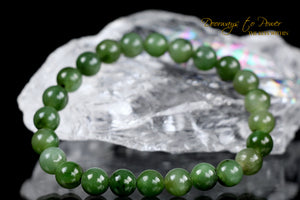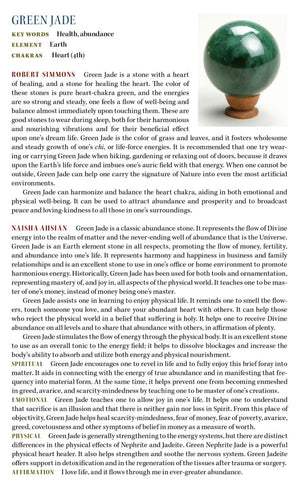Your Cart is Empty


Sale
Imperial Green Jade Crystal Bracelet
$ 253.30$ 298.00
Symbolizing purity and moral integrity and prized for its otherworldly magical qualities, imperial jade is a gemstone that is revered in Chinese culture with a unique significance that is difficult for outsiders to understand. From the discovery of the earliest nephrite jade deposits to the more recent arrival of imperial green jade, or jadeite, it is interwoven into China's wonderfully rich and vibrant history. Here is the story of imperial jade and Chinese jade jewelry.
8 mm Top quality Imperial Green Jade beads , one size fits all, elastic stretch bracelets, which max up at about 7" inches.
Imperial Jade - An Introduction
Gold has a price; jade is priceless (Chinese proverb)
In China, the rich, emerald green gemstone known as imperial jade is a symbol of status, of purity, of deep spirituality and of good health. It is no coincidence that in Chinese writing, the character for 'jade' is virtually identical to the character for 'emperor.'
Chinese jade jewelry is as highly prized as the finest diamond, ruby and sapphire jewelry is in the West. Unlike nephrite, or 'mutton fat' jade which has been in China for thousands of years, the stunning imperial green jade known as jadeite was introduced from Burma (now Myanmar) as recently as the 18th century.
The Origins and History of Chinese Jade Jewelry in China
The significance of imperial jade to Chinese history and culture should not be underestimated. Chinese jade jewelry has been made since the first deposits were found in Neolithic times and archaeological digs have uncovered ornaments as well as tools and weapons such as axe-heads and daggers.
By around 3,000 BC, this most precious of hardstones became revered with an almost otherworldly significance and was known by the Chinese character 'yu' or 'royal gem'. It was used for intricate carvings, decorations in the homes of the wealthy and entitled, royal and religious ceremonies and was made into the most beautifully detailed pieces of Chinese jade jewelry for the imperial families.
In his seminal work Shuowen Jiezi, Han dynasty scholar Xu Shen detailed the five virtues of imperial jade in the 2nd century -
Benevolence - for its luster and brilliance
Honesty - for its translucent texture
Wisdom - for its tranquil and far-reaching tone
Integrity and Bravery - for it may be broken but cannot be twisted
Nephrite jade had been used in China for millennia - archaeological data suggests that the Chinese were using it almost 8,000 years ago in the smoke-fogged caves that sheltered prehistoric man - but it wasn't until the late 1700s that jadeite, or imperial green jade reached China from Burma (now Myanmar). Through the late eighteenth and early nineteenth centuries, China's finest artisan craftsmen created magnificent imperial jade jewelry and other masterpieces from imperial green jade that remain unsurpassed to this day for their design, intricacy, quality and technical execution.
Chinese culture associates imperial jade with a purity of spirit and clarity of thought and many of the ancient symbolic motifs are still used today. For example bats are associated with happiness, butterflies signify a long life, dragons suggest power, prosperity and goodness and peaches are a sign of immortality.
According to myth, the first boulder of jadeite arrived in China from Myanmar's (then Burma's) northernmost state, the Kachin State. It was supposedly carried by a merchant on the back of a mule with the sole purpose of balancing his load. He had no idea he was carrying imperial jadeite or the importance of that journey to Chinese culture.
The often mysterious world of imperial jade is complex. The most experienced buyers can recall with absolute clarity the rough stones and pieces of Chinese jade jewelry they saw years before. They then apply that knowledge to similar stones and finished pieces and they can make accurate and informed predictions of value.
Another fascinating aspect of the innermost world of trading imperial jade is the buying and selling process. Across China, imperial green jade is often still bought and sold using the ancient ritual of secrecy. To keep the bidding prices secret, the buyer holds the piece of jade he wants in one hand and holds hands with the seller under a cloth with his other hand. The buyer only says two words - the word for 'hundred' or the word for 'thousand' and signals under the cloth with his fingers a number between one and ten. If he extends four fingers under the cloth and says the word for 'thousand', he's making a bid for 4,000. The seller then chooses to accept or reject the offer for the piece of imperial jadeite and the process either stops or continues.


